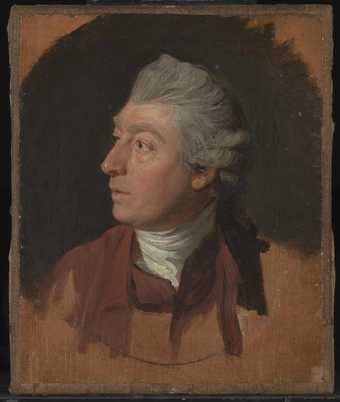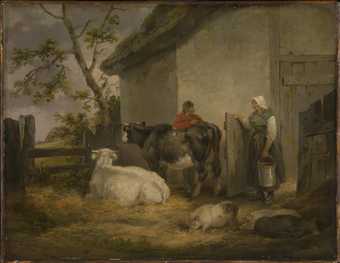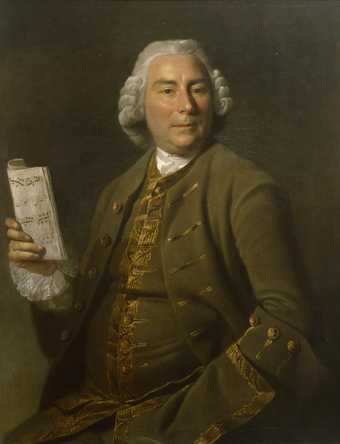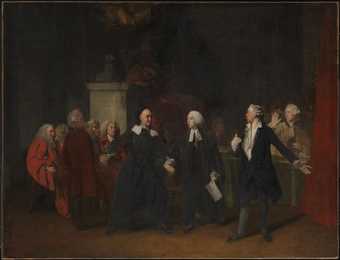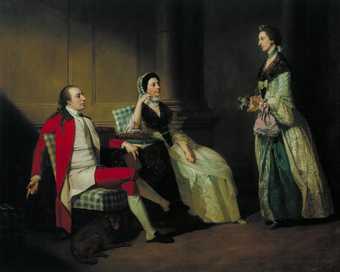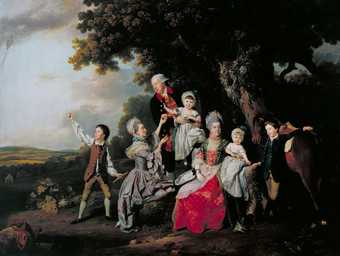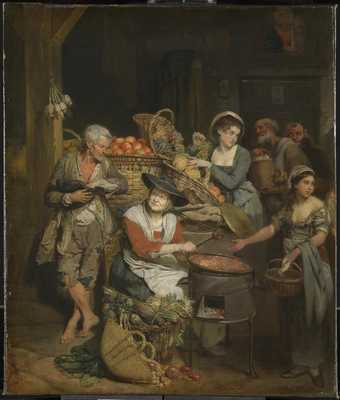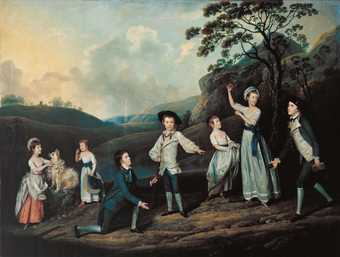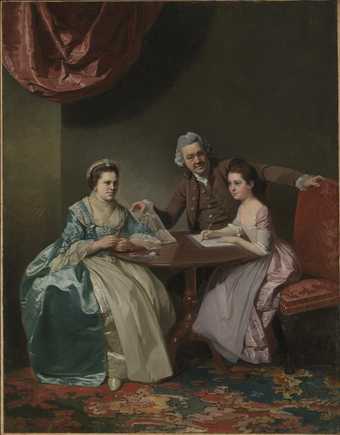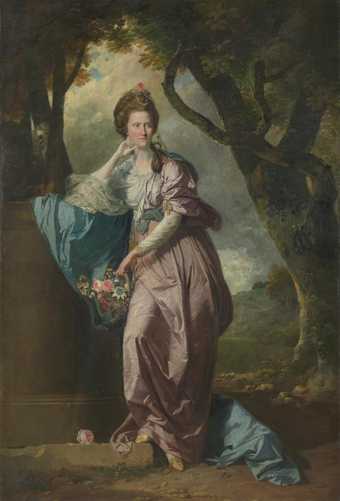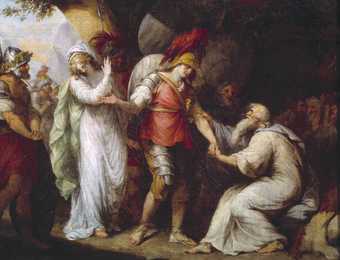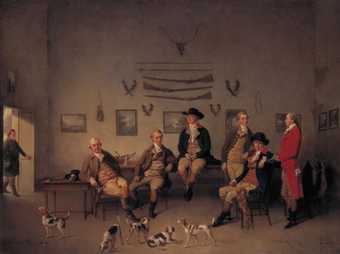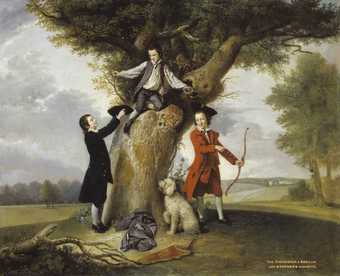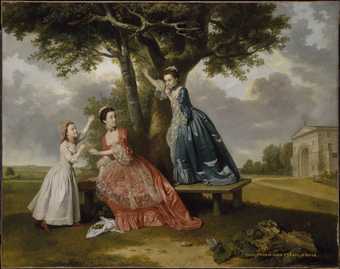
In Tate Britain
- Artist
- Johan Zoffany 1733–1810
- Medium
- Oil paint on canvas
- Dimensions
- Support: 1039 × 1500 × 20 mm
frame: 1235 × 1695 × 85 mm - Collection
- Tate
- Acquisition
- Purchased with assistance from the National Heritage Memorial Fund, the Art Fund, the Friends of the Tate Gallery and a group of donors 1994
- Reference
- T06856
Summary
This dynamic painting, teeming with animated figures, shows a cock-fight involving birds belonging to Asaf-ud-Daula, the Nawab Wazir (governor) of Awadh and Colonel John Mordaunt, an employee of Britain’s East India Company. The birds have just been released by their Indian handlers. Asaf, the figure standing at the centre, appears to have jumped from his seat to bet with Mordaunt, who gestures to his own bird. The Nawab’s uncle, Salar Jung, calculates the bet on his fingers. Around them is a multitude of Indian and European figures, around ninety in total. Some can be identified by name, like Claude Martin, wearing a red uniform sitting on the white settee on the right. He was a French-born defector to the East India Company, who supervised the Nawab’s arsenal, and a friend of the painter of this work, Johan Zoffany. Behind Salar Jung, in brightly coloured clothes, are Asaf’s chief ministers, Hasan Reza Khan and Haidar Ali Khan. There are numerous narrative details intended to engage the viewer’s attention: the dancing girls, musicians, a water-seller, and an elephant in the distance. Zoffany himself sits with his arm over a chair in the right background, dressed in white evening wear like Mordaunt. Standing next to him is Ozias Humphry, another artist who had come from Britain in search of new opportunities.
The painting was created in India when Britain was taking a growing commercial and military interest in the region. Zoffany, who was born in Germany but had been based in Britain previously, moved to India to seek his fortune. The artist referred to this painting as ‘an Historical picture’ (quoted in Webster 2011, p.509). This indicates that he considered it as a form of history painting, an ambitious narrative image commemorating an important event, and not just an observational scene. The cross-cultural context in which this painting was made and which it sets out to represent makes it quite unlike other ‘Historical’ pictures, which were generally based on the established European literary and documentary sources. The dense, ambiguous imagery has drawn much attention from modern commentators, and the painting has been newly considered as a complex document of early Anglo-Indian life, embodying ‘the tensions, the cosmopolitanism and the critical multi-culturalism of late-eighteenth century Lucknow’ (Eaton 2007, p.189).
The East India Company was the commercial organisation that spearheaded British exploitation of the Indian subcontinent in the eighteenth century. Asaf, a puppet ruler for the Company, was given to extravagant display, whether in extensive building projects, his large menagerie of animals (including many fighting cocks) or in his extensive art collection. Mordaunt stayed at Asaf’s court for many years, chiefly to organise the amusements, including cock-fighting. Quite how this painting of an elite Anglo-Indian social event sets out the power relations between these European and Indian figures, and how it may distort or misrepresent the realities of Britain’s exploitation of the subcontinent, has been subject to ongoing historical analysis. For the art historian Griselda Pollock, the picture’s composition presents a colonialist viewpoint by putting the focus on the encounter between Asaf and Mordaunt, presenting most of the Indian figures as passive spectators and ‘leaving the impressive Nawab a diminished figure, paling at its centre’ (Pollock 2003, p.159). Others have emphasised the cultural diversity of the social world pictured by Zoffany, the dynamic context of cross-cultural exchange and collecting, and the complex status of Mordaunt. Although he is a dominant figure in Zoffany’s composition, Mordaunt was reputedly near-illiterate, and the illegitimate son of the Earl of Peterborough, so hardly conformed to the stereotype of an imperial hero.
Whichever way the painting is interpreted, its unruly imagery and its presentation of Anglo-Indian life are highly unusual, and seems to involve a mixture of knowing satire, criticism and celebration. While a European viewpoint is given primacy by Zoffany’s picture – not least by the way that the white figures in the composition dominate the foreground – there are also elements of complexity and contradiction in play. The value and morality of imperial expansion was much discussed in Britain, even as the East India Company helped create fortunes for some, and this certainly forms a context for how the painting might have been understood in Britain, where it was displayed and published as a print. It is significant that this scene shows a bloodsport – cock-fighting – which was widely disapproved of in Britain. Contemporary European commentators often expressed disquiet about what was perceived to be the relaxed morals and rampant self-interest associated with the Company’s activities in India, and this picture confronts such a moralising European perspective on colonial life by relishing in the spectacle of the lives of the elite at Lucknow.
Zoffany’s art characteristically included elements of sly comic reference and satire, sometimes of a frankly sexual nature. The array of intimate physical relationships and exchanged glances in this painting may include intimations of unconventional desires and relationships. This is an almost exclusively male occasion, with women quite literally marginalised; the only women present in the foreground group are hired dancing girls, eagerly accepting water from a water-seller on the left. The arrangement of the Nawab’s clothing around his groin has been interpreted as indicating that he was sexually aroused, which could have been intended to demean him. Behind him a pallid boy in a white and pink costume appears to be limp and supported by an older man. Such physical intimacy between male figures is highly unusual in the context of an eighteenth-century painting, and the pair appear to be getting pointed at by an angry man in yellow. However, the presence of this group may be explained if the younger man is correctly identified as the disabled son of one of Asaf-ud-Duala’s brothers (Webster 2011, p.504).
Around the picture, many figures are strongly characterised to the point of caricature. In what was surely a deliberately comic contrast with the figure of Mordaunt, Zoffany has included a fat white man in the same costume, to the bottom right. This man is William Golding, a lieutenant in the East India Company’s Corps of Engineers, who was not actually present at the cock-fight but stood in for another overweight European who was there, but had refused to sit for this picture. Like Mordaunt, Golding wears white evening dress, a symbol of European social refinement, but in combination with Indian slippers, and adopts an artless pose that transgresses the norms of masculine elite demeanour. Whether the resulting image is a sly commentary on the moral and social libertinism of the Anglo-Indian elite, or a knowingly bullish assertion of European superiority, remains a matter of interpretation.
The painting was commissioned by the British Governor-General of India, General Warren Hastings. Although he does not appear in the scene, he was friendly with Mordaunt, and he may have wanted to commemorate a successful diplomatic mission he had conducted in Lucknow. The picture might appear to be wholly biased towards a Western perspective, but another version of the painting was owned by the Nawab himself, and apparently completed by an Indian artist (see Webster 2011, pp.507–9). Both versions proved to be popular, with prints and painted copies being made for Indian and European markets.
Further reading
Griselda Pollock, ‘Cockfights and Other Parades: Gesture, Difference, and the Staging of Meaning in Three Paintings by Zoffany, Pollock, and Krasner’, Oxford Art Journal, vol.26, no.2, 2003, pp.143–65.
Maya Jasanoff, Edge of Empire: Lives, Culture, and Conquest in the East, 1750–1850, New York 2005.
Natasha Eaton, ‘Critical Cosmopolitanism: Gifting and Collecting Art at Lucknow, 1775–97’, in T.J. Barringer, Geoff Quilley and Douglas Fordham, Art and the British Empire, Manchester and New York 2007, pp.189–204.
Mary Webster, Johan Zoffany, 1733–1810, New Haven and London 2011, pp.497–509.
Greg Sullivan
November 2013
Revised by Martin Myrone
May 2018
Does this text contain inaccurate information or language that you feel we should improve or change? We would like to hear from you.
Display caption
This ambitious painting shows a cock fight held at Lucknow, India, in 1784. The birds belong to Asaf-ud-Daula, the Nawab Wazir of Oudh, and John Mordaunt, an East India Company employee and colonel in Asaf’s personal bodyguard. They are surrounded by a cosmopolitan crowd including Indian courtiers and Company officials. The convivial scene evokes a Company culture of ‘taking part’ rather than ‘taking control’. However, Asaf had actually been stripped of any real power by the Company. Zoffany subtly hints at this imbalance in Anglo-Indian relations through the British bird’s domination over the Indian cockerel.
Gallery label, April 2023
Does this text contain inaccurate information or language that you feel we should improve or change? We would like to hear from you.
Explore
- emotions, concepts and ideas(16,416)
-
- emotions and human qualities(5,345)
- places of entertainment(399)
-
- marquee(5)
- sport(511)
-
- cockfighting(2)
- clothing and personal items(5,879)
-
- turban(39)
- actions: expressive(2,622)
-
- arguing(31)
- embracing(429)
- gesticulating(130)
- greeting(89)
- talking(602)
- arm / arms raised(839)
- bending forward(353)
- crouching(276)
- sitting(3,347)
- standing(3,106)
- boy(1,153)
- audience(103)
- self-portraits(888)
- cities, towns, villages (non-UK)(13,323)
-
- Lucknow(3)
- India(166)
- nationality(18,601)
- homosexuality(1,673)
- morality(57)
- arts and entertainment(7,210)
-
- artist, painter(2,545)
- nawab / raja(6)
You might like
-
Johan Zoffany Thomas Gainsborough
c.1772 -
George Morland Cowherd and Milkmaid
1792 -
Johan Zoffany Stephen Rimbault
1764 -
Johan Zoffany Charles Macklin as Shylock
c.1768 -
John Hamilton Mortimer George Thompson, his Wife and (?) his Sister-in-Law
c.1766–8 -
Johan Zoffany The Bradshaw Family
exhibited 1769 -
Johan Zoffany A Florentine Fruit Stall
c.1777 -
Hugh Barron The Children of George Bond of Ditchleys
1768 -
Johan Zoffany Mr and Mrs Dalton and their Niece Mary de Heulle
c.1765–8 -
Johan Zoffany Mrs Woodhull
c.1770 -
Charles Reuben Ryley Oscar Bringing Back Annir’s Daughter
1785 -
Philip Reinagle Members of the Carrow Abbey Hunt
1780 -
Johan Zoffany Three Sons of John, 3rd Earl of Bute
c.1763–4 -
Johan Zoffany Three Daughters of John, 3rd Earl of Bute
c.1763–4 -
Johan Zoffany Colonel Blair with his Family and an Indian Ayah
1786

